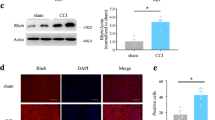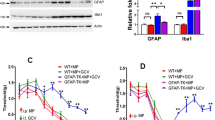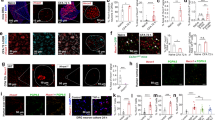Abstract
Opiate/narcotic analgesics are the most effective treatments for chronic severe pain, but their clinical utility is often hampered by the development of analgesic tolerance. Recent evidence suggests chronic morphine may activate glial cells to release proinflammatory cytokines. In this study, we used herpes simplex virus (HSV) vector-based gene transfer to dorsal root ganglion to produce a local release of p55 tumor necrosis factor (TNF) soluble receptor in the spinal cord in rats with morphine tolerance. Subcutaneous inoculation of HSV vectors expressing p55 TNF soluble receptor into the plantar surface of the hindpaws enhanced the antinociceptive effect of acute morphine in rats. Subcutaneous inoculation of those vectors into hindpaws also delayed the development of chronic morphine tolerance in rats. TNF soluble receptor expressed by HSV vector reduced gene transcription of spinal TNFα and interleukin-1β (IL-1β) induced by repeated morphine. Furthermore, we found that TNF soluble receptor mediated by HSV reversed the upregulation of protein level of TNFα and IL-1β and phosphorylation of p38 mitogen-activated protein kinase induced by repeated morphine. These results support the concept that proinflammatory cytokines may have an important role in the pathogenesis induced by morphine. This study provides a novel approach to treating morphine tolerance.
This is a preview of subscription content, access via your institution
Access options
Subscribe to this journal
Receive 12 print issues and online access
$259.00 per year
only $21.58 per issue
Buy this article
- Purchase on Springer Link
- Instant access to full article PDF
Prices may be subject to local taxes which are calculated during checkout







Similar content being viewed by others
References
Bekhit MH . Opioid-induced hyperalgesia and tolerance. Am J Ther 2010; 17: 498–510.
Xie JY, Herman DS, Stiller CO, Gardell LR, Ossipov MH, Lai J et al. Cholecystokinin in the rostral ventromedial medulla mediates opioid-induced hyperalgesia and antinociceptive tolerance. J Neurosci 2005; 25: 409–416.
Johnston IN, Milligan ED, Wieseler-Frank J, Frank MG, Zapata V, Campisi J et al. A role for proinflammatory cytokines and fractalkine in analgesia, tolerance, and subsequent pain facilitation induced by chronic intrathecal morphine. J Neurosci 2004; 24: 7353–7365.
Mao J, Sung B, Ji RR, Lim G . Chronic morphine induces downregulation of spinal glutamate transporters: implications in morphine tolerance and abnormal pain sensitivity. J Neurosci 2002; 22: 8312–8323.
Tsuda M, Shigemoto-Mogami Y, Koizumi S, Mizokoshi A, Kohsaka S, Salter MW et al. P2X4 receptors induced in spinal microglia gate tactile allodynia after nerve injury. Nature 2003; 424: 778–783.
Tsuda M, Inoue K, Salter MW . Neuropathic pain and spinal microglia: a big problem from molecules in ‘small’ glia. Trends Neurosci 2005; 28: 101–107.
Watkins LR, Hutchinson MR, Johnston IN, Maier SF . Glia: novel counter-regulators of opioid analgesia. Trends Neurosci 2005; 28: 661–669.
Mika J . Modulation of microglia can attenuate neuropathic pain symptoms and enhance morphine effectiveness. Pharmacol Rep 2008; 60: 297–307.
Song P, Zhao ZQ . The involvement of glial cells in the development of morphine tolerance. Neurosci Res 2001; 39: 281–286.
Mika J, Korostynski M, Kaminska D, Wawrzczak-Bargiela A, Osikowicz M, Makuch W et al. Interleukin-1 alpha has antiallodynic and antihyperalgesic activities in a rat neuropathic pain model. Pain 2008; 138: 587–597.
Cui Y, Liao XX, Liu W, Guo RX, Wu ZZ, Zhao CM et al. A novel role of minocycline: attenuating morphine antinociceptive tolerance by inhibition of p38 MAPK in the activated spinal microglia. Brain Behav Immun 2008; 22: 114–123.
Raghavendra V, Rutkowski MD, DeLeo JA . The role of spinal neuroimmune activation in morphine tolerance/hyperalgesia in neuropathic and sham-operated rats. J Neurosci 2002; 22: 9980–9989.
Raghavendra V, Tanga FY, DeLeo JA . Attenuation of morphine tolerance, withdrawal-induced hyperalgesia, and associated spinal inflammatory immune responses by propentofylline in rats. Neuropsychopharmacology 2004; 29: 327–334.
Glorioso JC, Mata M, Fink DJ . Therapeutic gene transfer to the nervous system using viral vectors. J Neurovirol 2003; 9: 165–172.
Fink DJ, DeLuca NA, Goins WF, Glorioso JC . Gene transfer to neurons using herpes simplex virus-based vectors. Annu Rev Neurosci 1996; 19: 265–287.
Wilson SP, Yeomans DC, Bender MA, Lu Y, Goins WF, Glorioso JC . Antihyperalgesic effects of infection with a preproenkephalin-encoding herpes virus. Proc Natl Acad Sci USA 1999; 96: 3211–3216.
Goss JR, Mata M, Goins WF, Wu HH, Glorioso JC, Fink DJ . Antinociceptive effect of a genomic herpes simplex virus-based vector expressing human proenkephalin in rat dorsal root ganglion. Gene Therapy 2001; 8: 551–556.
Braz J, Beaufour C, Coutaux A, Epstein AL, Cesselin F, Hamon M et al. Therapeutic efficacy in experimental polyarthritis of viral-driven enkephalin overproduction in sensory neurons. J Neurosci 2001; 21: 7881–7888.
Antunes bras J, Becker C, Bourgoin S, Lombard M, Cesselin F, Hamon M et al. Met-enkephalin is preferentially transported into the peripheral processes of primary afferent fibres in both control and HSV1-driven proenkephalin A overexpressing rats. Neuroscience 2001; 103: 1073–1083.
Hao S, Mata M, Glorioso JC, Fink DJ . Gene transfer to interfere with TNFalpha signaling in neuropathic pain. Gene Therapy 2007; 14: 1010–1016.
Hao S, Mata M, Glorioso JC, Fink DJ . HSV-mediated expression of interleukin-4 in dorsal root ganglion neurons reduces neuropathic pain. Mol Pain 2006; 2: 6.
Zhou Z, Peng X, Hao S, Fink DJ, Mata M . HSV-mediated transfer of interleukin-10 reduces inflammatory pain through modulation of membrane tumor necrosis factor alpha in spinal cord microglia. Gene Therapy 2008; 15: 183–190.
Yokoyama H, Sasaki K, Franks ME, Goins WF, Goss JR, de Groat WC et al. Gene therapy for bladder overactivity and nociception with herpes simplex virus vectors expressing preproenkephalin. Hum Gene Ther 2009; 20: 63–71.
Peng XM, Zhou ZG, Glorioso JC, Fink DJ, Mata M . Tumor necrosis factor-alpha contributes to below-level neuropathic pain after spinal cord injury. Ann Neurol 2006; 59: 843–851.
Hutchinson MR, Coats BD, Lewis SS, Zhang Y, Sprunger DB, Rezvani N et al. Proinflammatory cytokines oppose opioid-induced acute and chronic analgesia. Brain Behav Immun 2008; 22: 1178–1189.
Shavit Y, Wolf G, Goshen I, Livshits D, Yirmiya R . Interleukin-1 antagonizes morphine analgesia and underlies morphine tolerance. Pain 2005; 115: 50–59.
Cui Y, Chen Y, Zhi JL, Guo RX, Feng JQ, Chen PX . Activation of p38 mitogen-activated protein kinase in spinal microglia mediates morphine antinociceptive tolerance. Brain Res 2006; 1069: 235–243.
Wang Z, Ma W, Chabot JG, Quirion R . Cell-type specific activation of p38 and ERK mediates calcitonin gene-related peptide involvement in tolerance to morphine-induced analgesia. FASEB J 2009; 23: 2576–2586.
Wang HB, Zhao B, Zhong YQ, Li KC, Li ZY, Wang Q et al. Coexpression of delta- and mu-opioid receptors in nociceptive sensory neurons. Proc Natl Acad Sci USA 2010; 107: 13117–13122.
Ma W, Zheng WH, Powell K, Jhamandas K, Quirion R . Chronic morphine exposure increases the phosphorylation of MAP kinases and the transcription factor CREB in dorsal root ganglion neurons: an in vitro and in vivo study. Eur J Neurosci 2001; 14: 1091–1104.
Chen Y, Geis C, Sommer C . Activation of TRPV1 contributes to morphine tolerance: involvement of the mitogen-activated protein kinase signaling pathway. J Neurosci 2008; 28: 5836–5845.
Mellon RD, Bayer BM . Evidence for central opioid receptors in the immunomodulatory effects of morphine: review of potential mechanism(s) of action. J Neuroimmunol 1998; 83: 19–28.
McCarthy L, Wetzel M, Sliker JK, Eisenstein TK, Rogers TJ . Opioids, opioid receptors, and the immune response. Drug Alcohol Depend 2001; 62: 111–123.
Vanderah TW, Ossipov MH, Lai J, Malan Jr TP, Porreca F . Mechanisms of opioid-induced pain and antinociceptive tolerance: descending facilitation and spinal dynorphin. Pain 2001; 92: 5–9.
Hao S, Liu S, Zheng X, Zheng W, Ouyang H, Mata M et al. The role of TNFalpha in the periaqueductal gray during naloxone-precipitated morphine withdrawal in rats. Neuropsychopharmacology 2011; 36: 664–676.
Beitner-Johnson D, Guitart X, Nestler EJ . Glial fibrillary acidic protein and the mesolimbic dopamine system: regulation by chronic morphine and Lewis-Fischer strain differences in the rat ventral tegmental area. J Neurochem 1993; 61: 1766–1773.
Hutchinson MR, Lewis SS, Coats BD, Skyba DA, Crysdale NY, Berkelhammer DL et al. Reduction of opioid withdrawal and potentiation of acute opioid analgesia by systemic AV411 (ibudilast). Brain Behav Immun 2009; 23: 240–250.
Svensson CI, Marsala M, Westerlund A, Calcutt NA, Campana WM, Freshwater JD et al. Activation of p38 mitogen-activated protein kinase in spinal microglia is a critical link in inflammation-induced spinal pain processing. J Neurochem 2003; 86: 1534–1544.
Wu HE, Sun HS, Cheng CW, Tseng LF . p38 mitogen-activated protein kinase inhibitor SB203580 reverses the antianalgesia induced by dextro-morphine or morphine in the mouse spinal cord. Eur J Pharmacol 2006; 550: 91–94.
Wu HE, Thompson J, Sun HS, Terashvili M, Tseng LF . Antianalgesia: stereoselective action of dextro-morphine over levo-morphine on glia in the mouse spinal cord. J Pharmacol Exp Ther 2005; 314: 1101–1108.
Shen CH, Tsai RY, Shih MS, Lin SL, Tai YH, Chien CC et al. Etanercept restores the antinociceptive effect of morphine and suppresses spinal neuroinflammation in morphine-tolerant rats. Anesth Analg 2011; 112: 454–459.
Chen Y, Sommer C . The role of mitogen-activated protein kinase (MAPK) in morphine tolerance and dependence. Mol Neurobiol 2009; 40: 101–107.
Muscoli C, Doyle T, Dagostino C, Bryant L, Chen Z, Watkins LR et al. Counter-regulation of opioid analgesia by glial-derived bioactive sphingolipids. J Neurosci 2010; 30: 15400–15408.
Muscoli C, Cuzzocrea S, Ndengele MM, Mollace V, Porreca F, Fabrizi F et al. Therapeutic manipulation of peroxynitrite attenuates the development of opiate-induced antinociceptive tolerance in mice. J Clin Invest 2007; 117: 3530–3539.
Watkins LR, Hutchinson MR, Rice KC, Maier SF . The ‘toll’ of opioid-induced glial activation: improving the clinical efficacy of opioids by targeting glia. Trends Pharmacol Sci 2009; 30: 581–591.
Horvath RJ, Landry RP, Romero-Sandoval EA, DeLeo JA . Morphine tolerance attenuates the resolution of postoperative pain and enhances spinal microglial p38 and extracellular receptor kinase phosphorylation. Neuroscience 2010; 169: 843–854.
Tanga FY, Nutile-McMenemy N, DeLeo JA . The CNS role of Toll-like receptor 4 in innate neuroimmunity and painful neuropathy. Proc Natl Acad Sci USA 2005; 102: 5856–5861.
Hutchinson MR, Bland ST, Johnson KW, Rice KC, Maier SF, Watkins LR . Opioid-induced glial activation: mechanisms of activation and implications for opioid analgesia, dependence, and reward. ScientificWorldJournal 2007; 7: 98–111.
Lewis SS, Hutchinson MR, Rezvani N, Loram LC, Zhang Y, Maier SF et al. Evidence that intrathecal morphine-3-glucuronide may cause pain enhancement via toll-like receptor 4/MD-2 and interleukin-1beta. Neuroscience 2010; 165: 569–583.
Hannun YA, Obeid LM . Principles of bioactive lipid signalling: lessons from sphingolipids. Nat Rev Mol Cell Biol 2008; 9: 139–150.
DeLeo JA, Tanga FY, Tawfik VL . Neuroimmune activation and neuroinflammation in chronic pain and opioid tolerance/hyperalgesia. Neuroscientist 2004; 10: 40–52.
Livak KJ, Schmittgen TD . Analysis of relative gene expression data using real-time quantitative PCR and the 2(−Delta Delta C(T)) method. Methods 2001; 25: 402–408.
Acknowledgements
This work was supported by grants from the NIH DA020078 (SH), DA026734 (SH), DA025527 (SH) and NS066792 (SH), Department of Veterans Affairs and the NINDS NS038850 and NIDDK DK044935 (DJF and MM). We acknowledge the excellent technical assistance of Vikram Thakur.
Author information
Authors and Affiliations
Corresponding author
Ethics declarations
Competing interests
David Fink receives compensation for professional services from the University of Michigan and from the Department of Veterans Affairs. He also receives payments from the University of Pittsburgh for patents owned by the University on which he is a co-inventor. All others authors declare no conflict of interest.
Rights and permissions
About this article
Cite this article
Sun, J., Liu, S., Mata, M. et al. Transgene-mediated expression of tumor necrosis factor soluble receptor attenuates morphine tolerance in rats. Gene Ther 19, 101–108 (2012). https://doi.org/10.1038/gt.2011.76
Received:
Revised:
Accepted:
Published:
Issue Date:
DOI: https://doi.org/10.1038/gt.2011.76
Keywords
This article is cited by
-
Neuronal and glial factors contributing to sex differences in opioid modulation of pain
Neuropsychopharmacology (2019)
-
Toll-like Receptor 4 Mediates Morphine-Induced Neuroinflammation and Tolerance via Soluble Tumor Necrosis Factor Signaling
Neuropsychopharmacology (2017)
-
IL-4 mediated by HSV vector suppresses morphine withdrawal response and decreases TNFα, NR2B, and pC/EBPβ in the periaqueductal gray in rats
Gene Therapy (2017)
-
Procyanidins alleviates morphine tolerance by inhibiting activation of NLRP3 inflammasome in microglia
Journal of Neuroinflammation (2016)
-
Blockade of neuronal dopamine D2 receptor attenuates morphine tolerance in mice spinal cord
Scientific Reports (2016)



